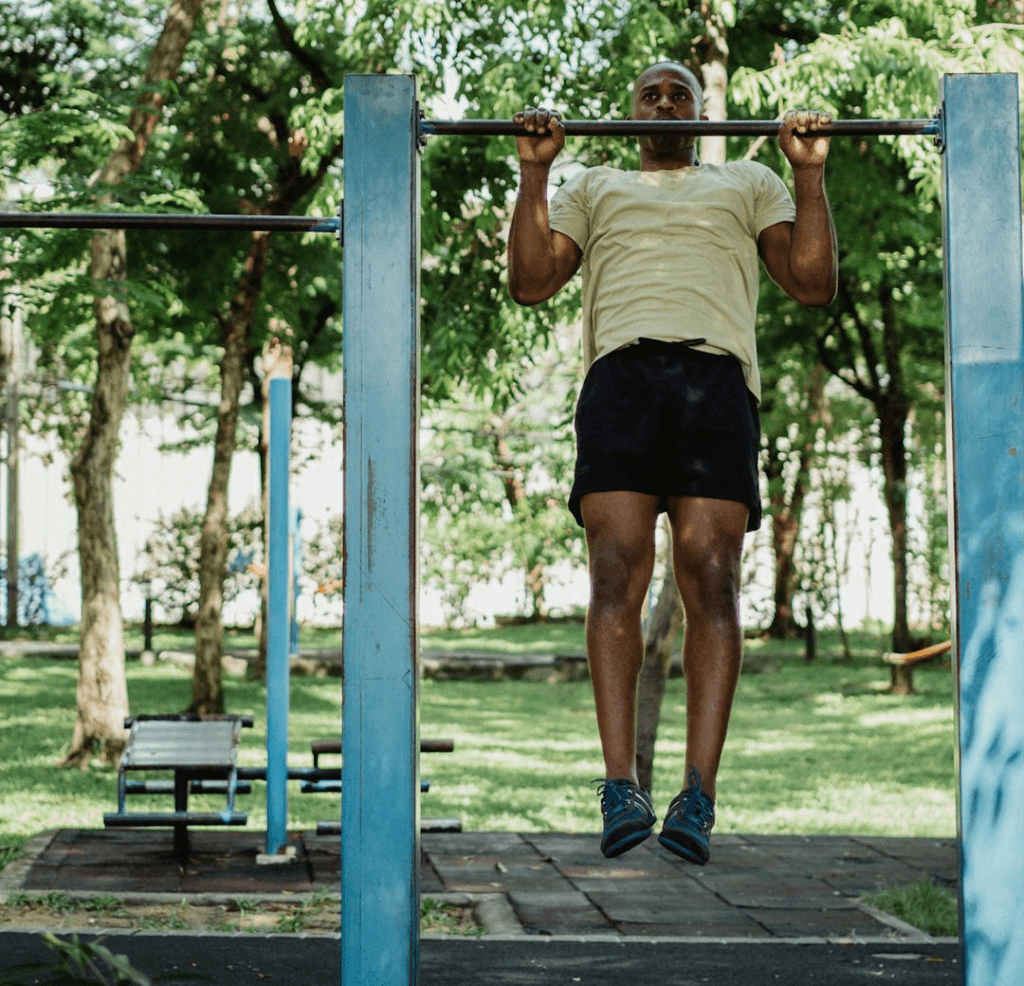Last Updated on October 3, 2025 by shawnshealth
Master the Big 3 calisthenics exercises—push-ups, pull-ups, and squats—to build strength, endurance, and functional fitness.
Introduction to 3 Powerful Calisthenics Exercises
Calisthenics exercises are the foundation of bodyweight strength training, offering a simple yet powerful way to build muscle, endurance, and mobility. Whether you’re a beginner or an advanced athlete, mastering push-ups, pull-ups, and squats can transform your physique without the need for expensive equipment or a gym membership. In this article, we’ll explore why these three fundamental movements are all you need to develop full-body strength and functional fitness.
My Personal Take on Calisthenics: My Story
I mention this throughout my writings on exercise, fitness, weight loss and strength. Calisthenics is absolutely my favorite way of training! There are so many benefits both for strength and endurance gains but also for time management and being able to work out wherever and whenever I want. I like to travel, as I am also a history buff, so being able to work out in my hotel room or at a campground without having to search for a decent gym (hotels have notoriously poor gym setups) is such a huge plus!
At the same time, I never discount weightlifting or any other form of exercise as well, but for me, calisthenics gives me all the flexibility I need.
Remember, have fun!
💪 Explore Functional Fitness with Calisthenics Learn how push-ups, pull-ups, and squats build real-world strength—no gym required. Be sure to check out this article on Functional Fitness with a high focus on calisthenics to dive deeper into the Big 3 bodyweight exercises.

1. What Are Calisthenics Exercises?
Calisthenics exercises use bodyweight to build strength, endurance, and flexibility. Key exercises include:
- Push-ups – Strengthen the chest, shoulders, and triceps.
- Pull-ups – Develop back, biceps, and grip strength.
- Squats – Improve leg power and lower body endurance.
2. Are Push-Ups, Pull-Ups, and Squats Enough for Strength Training?
Yes, these exercises build full-body strength because they:
- Target major muscle groups for balanced development.
- Enhance functional fitness for daily movement.
- Allow progression with harder variations like archer push-ups and pistol squats.
3. How Can You Progress in Calisthenics?
To advance in calisthenics, increase difficulty by:
- Adding more reps and sets for endurance.
- Trying harder variations like weighted pull-ups and pistol squats.
- Slowing movements to maximize muscle activation and control.
Table of Contents
Medical Disclaimer: This content is for informational purposes only. Consult a healthcare professional before making any health or fitness changes.
Amazon Affiliate Disclaimer: As an Amazon Associate, I earn from qualifying purchases.
⚠️ Before You Dive In…
Want faster results from push-ups, pull-ups, and squats? Make sure you’re not holding yourself back. Avoid these 5 common calisthenics mistakes—from poor form and rushed progressions to recovery slip-ups. Train smarter and unlock real gains.
Why These Exercises Work
Push-Ups
Why: Push-ups are a compound movement that targets the chest, shoulders, triceps, and core, building upper-body strength and stability.
How: They improve functional fitness by mimicking natural pressing motions. Variations like incline push-ups or archer push-ups allow progressions.
When: Include push-ups 3–5 times weekly, either as part of a circuit or focused strength training.
🚀 Kickstart Your Fitness Journey Ready to build strength with zero equipment? Check out our article on beginner calisthenics to get that workout started!

Pull-Ups
Why: Pull-ups develop the upper back, biceps, and grip strength while engaging the core. They balance the pushing motions of push-ups, ensuring structural balance.
How: Variations (e.g., chin-ups, assisted pull-ups) allow accessibility for beginners and intensity for advanced athletes.
When: Schedule pull-up-focused days or integrate them into full-body workouts for optimal results.

Squats
Why: Squats target the quads, hamstrings, glutes, and core, making them vital for lower-body strength and mobility. They mimic everyday movements like sitting and standing.
How: From bodyweight squats to single-leg pistol squats, variations can build explosive power or improve joint health.
When: Perform squats 3–5 times a week, adjusting intensity to suit your goals.

How to Structure a Routine with Push-Ups, Pull-Ups, and Squats
Circuit Training Routine
This approach maximizes calorie burn and endurance while covering all major muscle groups.
- Push-Ups: 10–20 reps
- Pull-Ups: 5–10 reps (use a resistance band if needed)
- Squats: 15–20 reps
Complete as many rounds as possible (AMRAP) in 15–30 minutes.
Check out this great video from Strength Side – The 3 Exercises You Need!
Volume Training Routine
For hypertrophy and balanced training:
- Day 1 (Push): Push-ups, incline push-ups, or archer push-ups (4–6 sets of 10–20 reps).
- Day 2 (Pull): Pull-ups, chin-ups, or negative pull-ups (4–6 sets of 5–10 reps).
- Day 3 (Legs): Bodyweight squats, Bulgarian split squats, or jump squats (4–6 sets of 12–15 reps).
Rep choice: On these, don’t start out with your first set going to failure because you want enough left in the tank to get through all the sets. You want to choose a rep count that, at the end of your sets you will barely, or possibly not even, achieve the number you are striving for. Let’s say you are doing 5 sets of 10 reps. On that 5th set you should be struggling at 8 or 9 but doing your best to get to 10. Once you can complete the 10 reps per set, add reps and try to get to 5 sets of 11 reps next time.
Rest as needed between sets (suggest 1-2 minutes). Repeat the cycle weekly.
Authors Note: You can arrange this however it works for you. I prefer to do push and pull on the same day, then legs either later in the day or opposite days. Depending on my health and recovery ability I often do each exercise 3x weekly. Find how it works for you. Take your time.
📚 Trusted Insight from Harvard Health Want a no-frills way to build strength and mobility? Check out this Harvard Health article on Calisthenics—a simple, science-backed approach to bodyweight fitness.

Strength Training Routine
Focus on slow, controlled movements for maximum strength gains:
- Push-Ups: Perform slow push-ups or weighted variations (3–5 sets of 6–12 reps).
- Pull-Ups: Use weighted pull-ups or slow eccentrics (3–5 sets of 3–8 reps).
- Squats: Progress to pistol squats or tempo squats (3–5 sets of 6–10 reps).
Include 2–3 minutes of rest between sets for recovery.
Authors Note: Don’t just lower (otherwise referred to as the eccentric portion) randomly but choose a pace. Count 1-1000, 2-1000, 3-1000, etc. (whatever you want to do) on the way down, pause briefly, then you can either go slowly back up or, possibly a better option, press forcefully and quickly explode from the bottom position to the top.
Check out this video by K Boges detailing how to make you bodyweight exercises even better!
How to Get Started
- Assess Your Level: Use variations appropriate to your strength and mobility.
- Warm Up: Always prepare with dynamic stretches like arm circles, hip openers, and jumping jacks.
- Track Progress: Gradually increase reps, sets, or difficulty.
🎥 Video Resources for Mastery
- Push-Up Variations – Explore beginner to advanced techniques in 3 PUSHUP VARIATIONS (Do you need them?) by Hybrid Calisthenics. This video explains why different push-up styles matter and how to choose the right one for your goals.
- Pull-Up Progressions – Learn how to scale from Australian pull-ups to one-arm negatives in Pull-Ups LVL 1–10 (How To Progress Faster) by Chris Heria. Ideal for building strength across all levels.
- Squat Variations – Build leg power and balance with Squat Variations for Enhanced Leg Power and Balance by Jordan Yeoh Fitness. Great for mastering form and choosing the right squat for your routine
Common Mistakes and How to Avoid Them
- Push-Ups: Sagging hips or flared elbows can cause strain—keep your body straight and elbows at a 45-degree angle.
- Pull-Ups: Avoid jerking motions or incomplete range of motion—strive for controlled, full movements.
- Squats: Knees caving inward or leaning too far forward—engage your core and track knees over toes.
Why Push-Ups, Pull-Ups, and Squats Are Enough
- Efficiency: Cover all major muscle groups in one routine.
- Adaptability: Exercises can be scaled for beginners to advanced athletes.
- Functionality: Mimic real-life movements, promoting strength and injury prevention.
- No Equipment Needed: Perfect for home or on-the-go workouts.
Conclusion
Push-ups, pull-ups, and squats aren’t just the building blocks of bodyweight fitness; they’re all you need to achieve strength, endurance, and mobility. By focusing on proper form, structured routines, and gradual progression, these exercises can transform your fitness journey—whether you’re a beginner or an advanced athlete.
Want to learn more about bodyweight training? Check out The Ultimate Calisthenics FAQ: Everything You Need to Know About Bodyweight Training for a complete guide to calisthenics, including exercises, tips, and expert advice to help you get stronger and move better.

💬 Who am I?
Discover my journey from martial arts to calisthenics, and how I’ve built a practical, real-world approach to health, fitness, and sustainable weight loss. With a background in psychology and protective services, I combine mental resilience with physical strength — all grounded in faith, discipline, and a passion for helping others move better and feel stronger.
👉 Read my full story — and see how my experience can support your fitness journey.
🔥 Gear to Help You Achieve Your Health and Fitness Goals 💪
If you’re looking for tools to enhance your fitness journey, check out this. Explore top-rated fitness gear on Amazon to enhance your workouts. Check out the latest picks here! 🛒 to support your workouts and progress.
🚀 Find equipment designed to boost strength, endurance, and overall performance!
⚠️ Short disclaimer: As an Amazon Associate, I earn from qualifying purchases.
FAQ: Calisthenics Exercises
- What are the Big 3 calisthenics exercises?
Push-ups, pull-ups, and squats are fundamental bodyweight exercises that build strength and endurance. - How often should I do these exercises?
Aim for 3-4 times per week, allowing rest days between workouts for recovery. - Can I progress with just push-ups, pull-ups, and squats?
Yes, by increasing reps, sets, or trying more advanced variations, you can continuously challenge yourself. - Are these exercises suitable for beginners?
Absolutely! Start with modified versions and gradually work up to full movements. - What muscles do these exercises target?
Push-ups target the chest, shoulders, and triceps; pull-ups focus on the back and biceps; squats strengthen the legs and core.
For God gave us a spirit not of fear but of power and love and self-control. – 2 Timothy 1:7




